by Jerry Petersen
My 5200 bottom project on my 1934 GarWood is proceeding. I decided to remove all of the old ribs to clean and to seal the related keel and chine rabbits. I wanted to be sure that rot was not starting in the rabbits, and I also wanted to seal the rabbits with Clear Penetrating Epoxy Sealer (CPES) to prevent rot from starting in the future. Fortunately, all the rabbits looked fine with the exception of those in the aft sections of the chines which are being replaced. However, I found that some of the ribs had lengthwise cracks. Hence, once I had them off the hull, I decided to replace all of them.
The first step was to plane a white oak plank to half inch thickness, and then to cut it into one inch wide strips on my table saw. These strips were then used to make copies of each original rib. Some had angle cuts at the chine end. Most also had thinned ends at the keel rabbit. I used my joiner to plane the keel end thickness of these ribs on a progressive basis until a good fit was obtained. Each side of this boat has twenty (20) ribs. The aft dozen on each side dont curve enough to require steam bending. These ribs were easily pulled down to the correct curvature by 1½ inch silicon bronze screws at their center where they attach to stringer support blocks. However, the forward eight ribs on each side curved enough to require steam bending. Fortunately, I had a steam generator and steam chambers on hand from my prior 1939 GarWood restoration project.
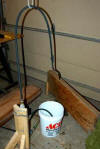 Figure 1 shows my overall steaming setup. You can see the steam hose from my generator which injects steam into the top of my small steam box.
Figure 1 shows my overall steaming setup. You can see the steam hose from my generator which injects steam into the top of my small steam box.
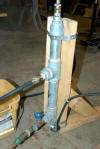 Figure 2 shows the details of the steam generator. It was built using standard pipe fittings and a heavy duty 220 volt hot water heater element. It was constructed with 1½ inch galvanized pipe nipples, two tees, and a reducer at the top. The heater element screws into the bottom of the lower tee. Water feed enters the side of this tee through two valves; a needle valve to control flow rate, and a gate valve to stop flow when the unit is shut down. An overflow port is located in the middle. The purpose of the overflow port is to keep the electric heater submerged at all times. This is accomplished by adjusting the needle flow control valve so that some water continuously discharges from the overflow.
Figure 2 shows the details of the steam generator. It was built using standard pipe fittings and a heavy duty 220 volt hot water heater element. It was constructed with 1½ inch galvanized pipe nipples, two tees, and a reducer at the top. The heater element screws into the bottom of the lower tee. Water feed enters the side of this tee through two valves; a needle valve to control flow rate, and a gate valve to stop flow when the unit is shut down. An overflow port is located in the middle. The purpose of the overflow port is to keep the electric heater submerged at all times. This is accomplished by adjusting the needle flow control valve so that some water continuously discharges from the overflow.
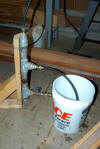 As shown in Figure 3, I keep the end of the overflow hose near the bottom of a bucket containing some water. This prevents steam from exiting through the overflow port. Dry steam exits from the top of the unit. The three ports all have standard hose thread fittings. I have used a garden hose to feed the unit, but I find that gravity feed from a five gallon bucket works better. This provides a constant head and a very uniform flow rate.
As shown in Figure 3, I keep the end of the overflow hose near the bottom of a bucket containing some water. This prevents steam from exiting through the overflow port. Dry steam exits from the top of the unit. The three ports all have standard hose thread fittings. I have used a garden hose to feed the unit, but I find that gravity feed from a five gallon bucket works better. This provides a constant head and a very uniform flow rate.
Figure 4 shows the open end of my steam box. The box was constructed from some scrap plywood and 2 by 2s. The bottom has several internal spacer blocks so that the pieces being steamed dont rest directly on the bottom where liquid water may be present. If you look carefully, you can see the end of a rib being steamed. I block the open end with an folded bath towel during steaming.
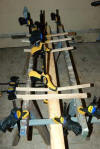 I find that an hour of steaming is more than adequate for white oak. However, once removed from the steam box, you have only about a minute to form the stock. In this case, I did the bending using a pair of saw horses with a 2 x 4 temporally suspended between them as shown on Figure 5. I used quick grip clamps to pull the center of the stock down until its curvature was close to that of the rib being replicated. In some cases, I used another quick grip clamp to twist the rib as well.
I find that an hour of steaming is more than adequate for white oak. However, once removed from the steam box, you have only about a minute to form the stock. In this case, I did the bending using a pair of saw horses with a 2 x 4 temporally suspended between them as shown on Figure 5. I used quick grip clamps to pull the center of the stock down until its curvature was close to that of the rib being replicated. In some cases, I used another quick grip clamp to twist the rib as well.
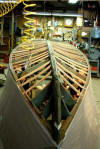 It all worked like a charm. Figure 6 shows all the new ribs in place on the hull.
It all worked like a charm. Figure 6 shows all the new ribs in place on the hull.
Im now turning my attention to interior hull painting, and installation of two new aft side planks, before I bed the new ribs into their rabbits with 5200.
Its easier to do this painting without the ribs blocking access from the top. I can crawl under the boat and work on my knees for some of the interior painting, however, its much more comfortable to do it from above using a small step stool. Interestingly, I observed that the bottom of some of the interior structure wasnt painted when, or since, the boat was built! This time around everything will get sealed and painted. Within two weeks, I should be cutting and fitting the interior hull 4 mil Okoume marine plywood.

